UNIT 2
Question-1: Evaluate

Sol. Here we notice that f:x→cos x is a decreasing function on [a , b],
Therefore by the definition of the definite integrals-

Then

Now,





Here 
Thus


Question-2: Evaluate 0∞ x3/2 e -x dx
Solution: 0∞ x3/2 e -x dx = 0∞ x 5/2-1 e -x dx
= γ (5/2)
= γ (3/2+ 1)
= 3/2 γ (3/2 )
= 3/2. ½ γ (½ )
= 3/2 .½.π
= ¾ π
Question-3: Determine the area enclosed by the curves-

Sol. We know that the curves are equal at the points of interaction, thus equating the values of y of each curve-

Which gives-

By factorization,

Which means,
x = 2 and x = -3
By determining the intersection points the range the values of x has been found-
x | -3 | -2 | -1 | 0 | 1 | 2 |
 | 10 | 5 | 2 | 1 | 2 | 5 |
And
x | -3 | 0 | 2 |
y = 7 - x | 10 | 7 | 5 |
We get the following figure by using above two tables-
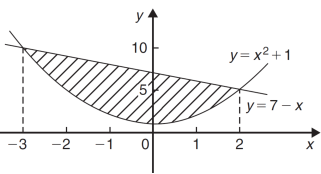
Area of shaded region = 

= 

= ( 12 – 2 – 8/3 ) – (-18 – 9/2 + 9)
= 
= 125/6 square unit
Question-4: Evaluate I = 
Solution:







= 2 π/3
Question-5: Find the area enclosed by the two functions-
 and g(x) = 6 – x
and g(x) = 6 – x
Sol. We get the following figure by using these two equations 
To find the intersection points of two functions f(x) and g(x)-
f(x) = g(x)




On factorizing, we get-

x = 6, -2
Now

Then, area under the curve-
A = 



Therefore the area under the curve is 64/3 square unit.
Question-6: Find the volume of the solid of revolution formed by revolving R around y-axis of the function f(x) = 1/x over the interval [1 , 3].
Sol. The graph of the function f(x) = 1/x will look like-

The volume of the solid of revolution generated by revolving R(violet region) about the y-axis over the interval [1 , 3]
Then the volume of the solid will be-


Question-7: Find the volume of the solid of revolution formed by revolving R around y-axis of the function f(x) = 2x - x² over the interval [0 , 2].
Sol. The graph of the function f(x) = 2x - x² will be-
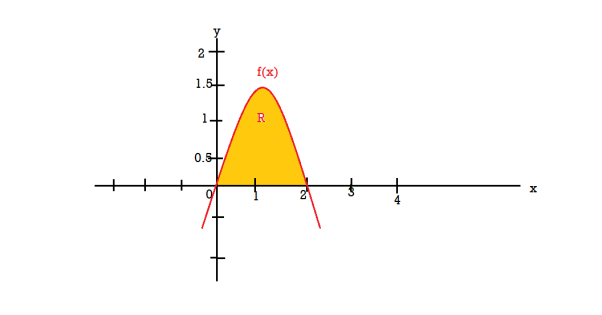
The volume of the solid is given by-



= 
Question-8: Evaluate , where dA is the small area in xy-plane.
, where dA is the small area in xy-plane.
Sol.
Let, I = 
= 
= 
= 
= 84 sq. Unit.
Which is the required area.
Question-9: Evaluate 
Sol. Let us suppose the integral is I,
I = 
Put c = 1 – x in I, we get
I = 
Suppose , y = ct
then dy = c
Now we get,
I = 
I = 
I = 
I = 
I = 
As we know that by beta function,

Which gives,



Now put the value of c, we get

Question-10: Evaluate  ey/x dy dx.
ey/x dy dx.
Sol.
Given: I =  ey/x dy dx
ey/x dy dx
Here limits of inner integral are functions of y therefore integrate w.r.t y,
I = 
 dx
dx
= 
= 
I = 
= =
 ey/x dy dx=
ey/x dy dx=
Question-11: Evaluate 
Sol.
Let,I =
Here limits for both x and y are constants, the integral can be evaluated first w.r.t any of the variables x or y.
I = dy 
I= 
= 
= 
= 
=
= 
 =
=
Question-12: Evaluate  over x 1, y
over x 1, y 
Sol.
 Let I=
Let I= over x 1, y
over x 1, y 
The region bounded by x 1 and y 
Is as shown in Fig. 6.3.
Fig. 6.3
Take a vertical strip along strip x constant and y varies from y = 
To y = . Now slide strip throughout region keeping parallel to y-axis. Therefore y constant and x varies from x = 1 to x = .
I= 
= 
=  [ ∵
[ ∵ dx = tan–1 (x/a)]
dx = tan–1 (x/a)]
=  =
=
=– = (0 – 1)
I =
Question-13: Evaluate
Soln. :
The region of integration bounded by
y = 0, y =  and x = 0, x = 1
and x = 0, x = 1
y =  x2 + y2 = x
x2 + y2 = x
The region bounded by these is as shown in Fig

Convert the integration in polar co-ordinates by using x = r cos , y = r sin and dx dy = r dr d
x2 + y2= x becomes r = cos
y = 0 becomes r sin = 0 = 0
x = 0 becomes r cos = 0 =
And x = 1 becomes r = sec Fig. 6.8
Take a radial strip SR with angular thickness , Along strip constant and r varies from r = 0 to r = cos . Turning strip throughout region therefore varies from = 0 to =
I =  r dr d
r dr d
= 4 cos sin d r  dr
dr
= 4 cos sin d [– ]
]
= – 2 cos sin [ +1] d
+1] d
= – 2 [cos sin  – cos sin ] d
– cos sin ] d
= –2  + 2 cos sin d
+ 2 cos sin d
= – + 2
= + 1 =
Question-14: Evaluate r sin dr d over the cardioid r = a (1 – cos ) above the initial line.
Soln. :
The cardioid r = a (1 – cos ) is as shown in Fig. 6.11. The region of the integration is above the initial line.
Take a radial strip SR, along strip constant and r Varies from r = 0 to r = a (1 – cos ).
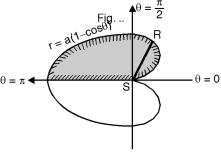 New turning the strip throughout region therefore varies from = 0 to = .
New turning the strip throughout region therefore varies from = 0 to = .
I= r sin dr d
= sin d
Fig.6.11
=sin [a2 (1 – cos )2]
= 
I= (sin – 2 sin cos + sin
(sin – 2 sin cos + sin  ) d
) d
=  2 (sin – sin2 + sin
2 (sin – sin2 + sin  ) d
) d
= +
+
I= a2= a2
I= 
Question-15: Find the area enclosed by two curves using double integration.
y = 2 – x and y² = 2 (2 – x)
Sol. Let,
y = 2 – x ………………..(1)
And y² = 2 (2 – x) ………………..(2)
On solving eq. (1) and (2)
We get the intersection points (2,0) and (0,2) ,
We know that,
Area = 

Here we will find the area as below,
Area = 


Which gives,
= ( - 4 + 4 /2 ) + 8 / 3 = 2 / 3.
Question-16: Find the are lying inside a cardioid r = 1 + cos θ and ouside the parabola r(1 + cos θ) = 1.
Sol. Let,
r = 1 + cos θ ……………………..(1)
r(1 + cos θ) = 1……………………..(2)
Solving these equestions , we get
(1 + cos θ )( 1 + cos θ ) = 1
(1 + cos θ )² = 1
1 + cos θ = 1
Cos θ = 0
θ = ±π / 2
So that, limits of r are,
1 + cos θ and 1 / 1 + cos θ
The area can be founded as below,

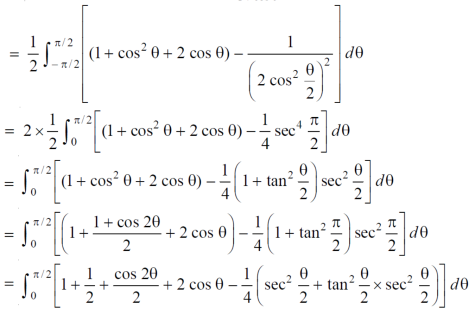

Question-17: Evaluate

Solution:-






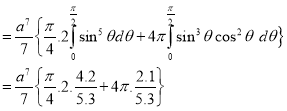

Question-18: If the density at any point of a non-uniform circular lamina of radius’ a’ varies as its distance from a fixed point on the circumference of the circle then find the mass of lamina.
Solution:
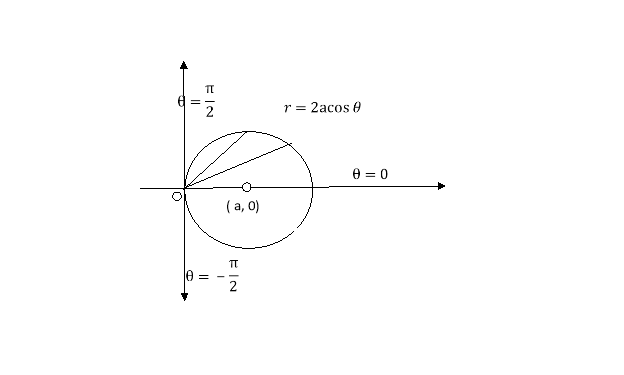
Take the fixed point on the circumference of the circle as origin and diameter through it as x axis. The polar equation of circle 
And density .
.

